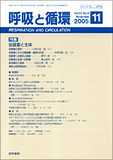Japanese
English
- 有料閲覧
- Abstract 文献概要
- 1ページ目 Look Inside
要旨 患者は31歳,男性.高校生時より不整脈を指摘されるも放置していた.近年運動時の前失神を自覚するようになり,近医を受診.12誘導心電図上心房頻拍(AT)が認められ当科紹介入院となった.Holter心電図上心拍数100~200/分の持続性ATを認め,洞調律時の左室造影にて左室駆出率(LVEF)=38%と収縮能低下を認めた.心臓電気生理学的検査(EPS)上,頻拍は非リエントリー性と考えられた.Brockenbrough法を用いた左房アプローチで僧帽弁輪後側壁に最早期興奮部位を認め,同部位の通電にてATは停止した.また,この際行った心室プログラム刺激において再現性ある心室細動の誘発が認められた.3カ月後の左室造影ではEF=58%と改善を示し,心室プログラム刺激にて心室細動誘発も認めなかった.
Summary
We report a case of left atrial tachycardia(AT) resulting in tachycardia-induced cardiomyopathy(TIC). The tachycardia was successfully terminated by radiofrequency catheter ablation(RFCA) resulting in improvement of the patient's LV systolic dysfunction. The case was that of a 31-year-old male, with clinical signs of near-syncope and palpitations during exercise. Holter-ECG revealed incessant type of AT with a heart rate of 100~200bpm, and left ventricular ejection fraction(LVEF) measured during sinus rhythm in echocardiography and left ventricular angiography(LVG) being 38%. There were no abnormal findings in coronary angiography. Electrophysiological study(EPS) revealed that the AT was due to a non-reentrant mechanism. Endocardial mapping during clinical tachycardia demonstrated the earliest atrial excitation was at the postero-lateral site of the mitral annulus, which the application of RFCA successfully terminated. We also performed ventricular programmed stimulations in this study and ventricular fibrillation(Vf) was reproducibly induced. Three months after the RFCA, LVEF in LVG improved to 58%, but the same ventricular programmed stimulation protocol did not induce Vf. The improvement of LVEF after the cure of AT confirmed diagnosis of TIC as the cause of the patient's reversible LV systolic dysfunction. It is unclear why Vf inducibility changed, but it may relate to the ventricular remodeling process induced by TIC.

Copyright © 2005, Igaku-Shoin Ltd. All rights reserved.


